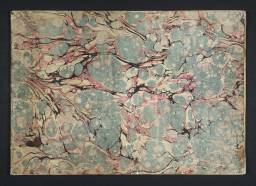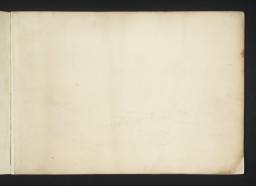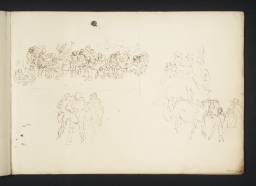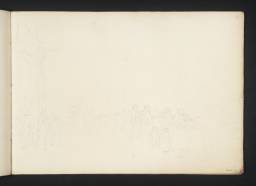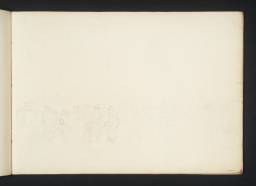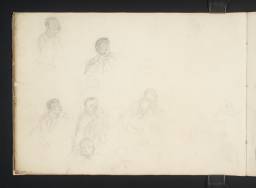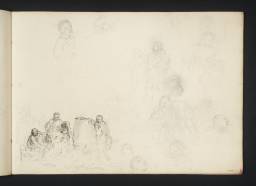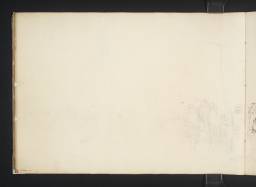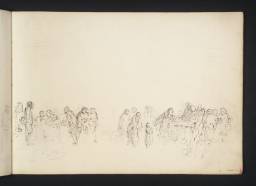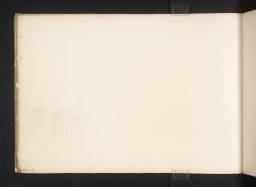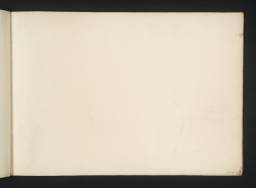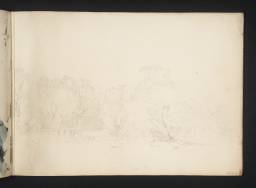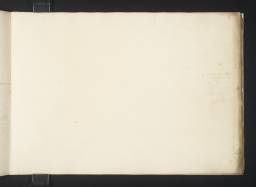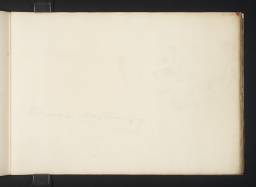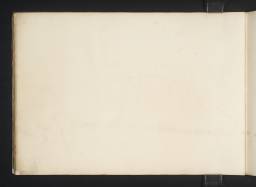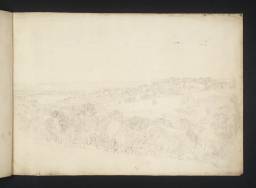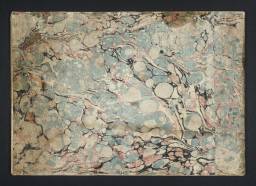Turner Bequest LXXXVI
Roll sketchbook, with blue and pink marbled laid paper covers
19 leaves of white wove paper, made on a double-faced mould
Approximate page size 258 x 370 mm
Made by William Balston and Finch and Thomas Robert Hollingworth at Turkey Mill, Kent, and watermarked ‘1797 | J. WHATMAN’
Endorsed by the Executors and inscribed by John Ruskin in ink ‘Inventory No.161 | One taken out | Seven left. Useless, except as samples of Turner’s | want of power over expression in human face. | They are sketches of a merrymaking, with failures in | trying to catch the expression of a drunken negro’ in a label inside the front cover. Also inscribed in another hand in ink ‘LXXXVI’. Inscribed and signed by Henry Scott Trimmer and Charles Turner in ink ‘No 161 | H.S. Trimmer’ and ‘C Turner’, and by Charles Lock Eastlake and John Prescott Knight in pencil ‘C.L.E.’ and ‘JPK’ inside front cover. Inscribed by an unknown hand in pencil ‘LXXXVI’ and stamped in black ‘LXXXVI’ inside front cover. A further note ‘A.B. 18, P.O. (Rubbish)’ is recorded by Finberg
19 leaves of white wove paper, made on a double-faced mould
Approximate page size 258 x 370 mm
Made by William Balston and Finch and Thomas Robert Hollingworth at Turkey Mill, Kent, and watermarked ‘1797 | J. WHATMAN’
Endorsed by the Executors and inscribed by John Ruskin in ink ‘Inventory No.161 | One taken out | Seven left. Useless, except as samples of Turner’s | want of power over expression in human face. | They are sketches of a merrymaking, with failures in | trying to catch the expression of a drunken negro’ in a label inside the front cover. Also inscribed in another hand in ink ‘LXXXVI’. Inscribed and signed by Henry Scott Trimmer and Charles Turner in ink ‘No 161 | H.S. Trimmer’ and ‘C Turner’, and by Charles Lock Eastlake and John Prescott Knight in pencil ‘C.L.E.’ and ‘JPK’ inside front cover. Inscribed by an unknown hand in pencil ‘LXXXVI’ and stamped in black ‘LXXXVI’ inside front cover. A further note ‘A.B. 18, P.O. (Rubbish)’ is recorded by Finberg
Accepted by the nation as part of the Turner Bequest 1856
References
Dated by Finberg 1804–9, this sketchbook was probably first used at Cassiobury Park, the Hertfordshire estate of the Earl of Essex, in 1807, and added to for several years afterwards, mainly in Kent but perhaps also in Sussex in 1810. It contains sketches of landscape, figures and estate life, chiefly a harvest supper in a barn.
Justifying his omission of the book from his selection of Turner’s drawings and sketchbooks, Wilkinson thought it ‘presumably intended for a genre-piece à la Teniers – not very inspiring’. In fact it was used in connection with two unfinished pictures, Harvest Home and Cassiobury Park; Reaping (Tate N00562, N04663),1 for which Turner also made separate composition studies (Tate D08216, D08217; Turner Bequest CXX C, CXX D). Presumed to be intended for the Earl, these were left unfinished, apparently because Turner took offence at some ‘remarks’ made by his rival Thomas Hearne. See catalogue note for D08216 for a suggestion that the ‘remarks’ were made in July 1809.
A recent visit by Turner to Cassiobury was noted by Joseph Farington on 15 November 1807.2 If in late summer it presumably coincided with the harvest supper of which sketches appear in this book. Turner seems to have been fond of such events, which he may have got into the habit of visiting with his friend William Frederick Wells and his family; in 1828 he was expected for the harvest home at Mitcham where they were then living and the following year apologised for missing the haymaking.3 This earlier harvest home is shown taking place in a barn, as Turner subsequently painted it, although in his separate composition study for the picture it is set in the open air. What seem to be early sketches of both outdoor and indoor versions, in chalks, are in the Studies for Pictures: Isleworth sketchbook (Tate D05546, D05548; Turner Bequest XC 36a, 37a), so perhaps Turner had taken this with him to Cassiobury as well. The sketches in the present book were first made in pencil, but some were worked over in pen and ink. Studies in pen and ink alone clearly include some made after 1807, notably a sketch closely based on a group of three figures – a wife trying to drag her reluctant husband away from further drinking with his friends – in David Wilkie’s picture The Village Holiday (Tate N00122). Wilkie was painting this from summer 1809 but it was not exhibited until 1812; see chiefly the entry to folio 2 of the sketchbook (D05352), and also to D08216, for additional comment.
It seems clear that Turner continued gathering material for Harvest Home for several years after the ‘remarks’ that allegedly made him abandon it; indeed he was at Cassiobury again in 1809. Further evidence for his later use of the sketchbook is the view on folio 8 (D05361) of Tonbridge Castle, Kent and that on folio 19 (D05375) of Somer Hill, near Tonbridge which he probably visited in 1810 on his way to stay with John Fuller at Rosehill Park, Sussex. The Somer Hill view shows a laden hay-cart crossing a field, indicating harvest-time. Perhaps Turner took the sketchbook with him with the idea of collecting further material for his harvest pictures. If so, not all the other sketches need relate to Cassiobury. Some might have been made at harvest time at Knockholt, where the Wells family then had their cottage, if such visits had already become a habit. Particularly tantalising are the various studies of a black steward or servant, clearly drawn from life in the sketchbook, who is also included in the painted Harvest Home. As recently observed by Sam Smiles, he may be Lord Essex’s Gambian servant George Edward Doney, who died in 1809, introduced at his employer’s request. Another possibility is that he worked for Fuller, who owned extensive plantations in the Caribbean and many slaves. Wherever Turner found him, his studies show him trying (even if Ruskin thought unsuccessfully) to incorporate life study, realism of gesture and expression into his picture-making. Here too he was competing with Wilkie, who was becoming admired for just these qualities. A black man, probably studied from an American Negro called Wilson, was an important figure in Wilkie’s Village Holiday, as Turner must have known. See D08216 for the further suggestion that, having abandoned hope of completing Harvest Home for Lord Essex, Turner redirected it towards Fuller. The features of the proprietor in the picture bear a marked resemblance to Fuller, on comparison with his portrait by Henry Singleton (Royal Institution, London) painted in 1806.
Technical notes
How to cite
David Blayney Brown, ‘Harvest Home sketchbook c.1807–10’, sketchbook, December 2009, in David Blayney Brown (ed.), J.M.W. Turner: Sketchbooks, Drawings and Watercolours, Tate Research Publication, December 2012, https://www

